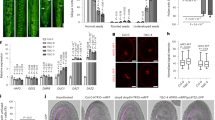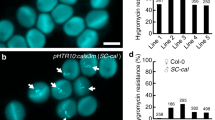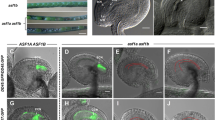Abstract
The double fertilization process in angiosperms is based on the delivery of a pair of sperm cells by the pollen tube (the male gametophyte), which elongates towards an embryo sac (the female gametophyte) enclosing an egg and a central cell. Several studies have described the mechanisms of gametophyte interaction1, and also the fertilization process — from pollination to pollen tube acceptance2,3,4,5. However, the mechanisms of gamete interaction are not fully understood6,7. Cytological studies have shown that male gametes possess distinct cell-surface structures8,9 and genes specific to male gametes have been detected in cDNA libraries10,11,12,13,14. Thus, studies of isolated gametes may offer clues to understanding the sperm–egg interaction. In this study, we identified a novel protein, designated GCS1 (GENERATIVE CELL SPECIFIC 1), using generative cells isolated from Lilium longiflorum pollen. GCS1 possesses a carboxy-terminal transmembrane domain, and homologues are present in various species, including non-angiosperms. Immunological assays indicate that GCS1 is accumulated during late gametogenesis and is localized on the plasma membrane of generative cells. In addition, Arabidopsis thaliana GCS1 mutant gametes fail to fuse, resulting in male sterility and suggesting that GCS1 is a critical fertilization factor in angiosperms.
This is a preview of subscription content, access via your institution
Access options
Subscribe to this journal
Receive 12 print issues and online access
$209.00 per year
only $17.42 per issue
Buy this article
- Purchase on Springer Link
- Instant access to full article PDF
Prices may be subject to local taxes which are calculated during checkout





Similar content being viewed by others
References
Weterings, K. & Russell, S. D. Experimental analysis of the fertilization process. Plant Cell 16, S107–S118 (2004).
Higashiyama, T. et al. Pollen tube attraction by the synergid cell. Science 293, 1480–1483 (2001).
Kim, S. et al. Chemocyanin, a small basic protein from the lily stigma, induces pollen tube chemotropism. Proc. Natl Acad. Sci. USA 100, 16125–16130 (2003).
Palanivelu, R., Brass, L., Edlund, A. F. & Preuss, D. Pollen tube growth and guidance is regulated by POP2, an Arabidopsis gene that controls GABA levels. Cell 114, 47–59 (2003).
Marton, M. L., Cordts, S., Broadhvest, J. & Dresselhaus, T. Micropylar pollen tube guidance by egg apparatus 1 of maize. Science 307, 573–576 (2005).
Faure, J.-E., Digonnet, C. & Dumas, C. An in vitro system for adhesion and fusion of maize gametes. Science 263, 1598–1600 (1994).
Faure, J.-E. et al. Double fertilization in maize: The two male gametes from a pollen grain have the ability to fuse with egg cells. Plant J. 33, 1051–1062 (2003).
Blomstedt, C. K., Xu, H., Singh, M. B. & Knox, R. B. The isolation and purification of surface specific proteins of somatic and reproductive protoplasts of lily and rapeseed. Physiol. Plant. 85, 396–402 (1992).
Southworth, D. & Kwiatkowski, S. Arabinogalactan proteins at the cell surface of Brassica sperm and Lilium sperm and generative cells. Sex. Plant Reprod. 9, 269–272 (1996).
Xu, H., Swoboda, I., Bhalla, P. L. & Singh, M. B. Male gametic cell-specific expression of H2A and H3 histone genes. Plant Mol. Biol. 39, 607–614. (1999).
Xu, H., Swoboba, I., Bhalla, P. L. & Singh, M. B. Male gametic cell-specific gene expression in flowering plants. Proc. Natl Acad. Sci. USA 96, 2554–2558 (1999).
Ueda, K. et al. Unusual core histones specifically expressed in male gametic cells of Lilium longiflorum. Chromosoma 108, 491–500 (2000).
Xu, H. et al. Isolation and characterization of male-germ-cell transcripts in Nicotiana tabacum. Sex. Plant Reprod. 14, 339–346 (2002).
Engel, M. L., Chaboud, A., Dumas, C. & McCormick, S. Sperm cells of Zea mays have a complex complement of mRNAs. Plant J. 34, 697–707 (2003).
Tanaka, I. Differentiation of generative and vegetative cells in angiosperm pollen. Sex. Plant Reprod. 10, 1–7 (1997).
May, S. T., Clements, D. & Bennett, M. J. Finding your knockout: reverse genetics techniques for plants. Mol. Biotechnol. 20, 209–221 (2002).
Rotman, N. et al. Female control of male gamete delivery during fertilization in Arabidopsis thaliana. Curr. Biol. 13, 432–436 (2003).
Huck, N., Moore, J. M., Federer, M. & Grossniklaus, U. The Arabidopsis mutant feronia disrupts the female gametophytic control of pollen tube reception. Development 130, 2149–2159 (2003).
Rotman, N. et al. A novel class of MYB factors controls sperm-cell formation in plants. Curr. Biol. 15, 244–248 (2005).
Cho, C. et al. Fertilization defects in sperm from mice lacking fertilin beta. Science 281, 1857–1859 (1998).
Inoue, N., Ikawa, M., Isotani, A., & Okabe, M. The immunoglobulin superfamily protein Izumo is required for sperm to fuse with eggs. Nature 434, 234–238 (2005).
Estelle, M. A. & Somerville, C. Auxin-resistant mutants of Arabidopsis thaliana with an altered morphology. Mol. Gen. Genet. 206, 200–206 (1987).
Moriyama, Y. & Kawano, S. Rapid, selective digestion of mitochondrial DNA in accordance with the matA hierarchy of multiallelic mating types in the mitochondrial inheritance of Physarum polycephalum. Genetics 164, 963–975 (2003).
Misumi, O. et al. Isolation and phenotypic characterization of Chlamydomonas reinhardtii mutant defective in chloroplast DNA segregation. Protoplasma 209, 273–282 (1999).
Nishimura, Y. et al. An mt+ gamete-specific nuclease that targets mt− chloroplasts during sexual reproduction in C. reinhardtii. Genes Dev. 16, 1116–1128 (2002).
Tanaka, I. Isolation of generative cells and their protoplasts from pollen of Lilium longiflorum. Protoplasma 142, 68–73 (1988).
Mori, T. & Tanaka, I. Isolation of the ftsZ gene from the plastid deficient generative cells in Lilium longiflorum. Protoplasma 214, 57–64 (2000).
Mori, T., Kuroiwa, H., Higashiyama, T. & Kuroiwa, T. Identification of higher plant GlsA, a putative morphogenesis factor of gametic cells. Biochem. Biophys. Res. Commun. 306, 564–569 (2003).
Yadegari, R. et al. Cell differentiation and morphogenesis are uncoupled in Arabidopsis raspberry embryos. Plant Cell 6, 1713–1729 (1994).
Sambrook, J., Fritsch, E. F. & Maniatis, T. Molecular Cloning, A Laboratory Manual (Cold Spring Harbor Laboratory Press, New York, 1989).
Bent, A. F. Arabidopsis in planta transformation. Uses, mechanisms, and prospects for transformation of other species. Plant Physiol. 124, 1540–1547 (2000).
Acknowledgements
We thank NASC for supplying the Arabidopsis T-DNA insertion mutant, F. Berger for supplying the transgenic Arabidopsis expressing DUO1–mRFP1, O. Misumi for providing C. reinhardtii, and Y. Moriyama and S. Kawano for providing P. polycephalum. This research was supported by a research fellowship from the Japanese Society for the Promotion of Science for Young Scientists (07962 and 08548) to T.M., by MEXT KAKENHI (16GS0304) to K.T. and by grants from the Ministry of Education, Culture, Sports, Science, and Technology of Japan (12446222 and 12874111), and from the Program for the Promotion of Basic Research Activities for Innovative Bioscience (ProBRAIN) to T.K.
Author information
Authors and Affiliations
Corresponding author
Ethics declarations
Competing interests
The authors declare no competing financial interests.
Rights and permissions
About this article
Cite this article
Mori, T., Kuroiwa, H., Higashiyama, T. et al. GENERATIVE CELL SPECIFIC 1 is essential for angiosperm fertilization. Nat Cell Biol 8, 64–71 (2006). https://doi.org/10.1038/ncb1345
Received:
Accepted:
Published:
Issue Date:
DOI: https://doi.org/10.1038/ncb1345
This article is cited by
-
EGG CELL 1 contributes to egg-cell-dependent preferential fertilization in Arabidopsis
Nature Plants (2024)
-
Optimized Refolding Buffers Oriented Humoral Immune Responses Versus PfGCS1 Self-Assembled Peptide Nanoparticle
Molecular Biotechnology (2024)
-
Vaccination of cattle with the Babesia bovis sexual-stage protein HAP2 abrogates parasite transmission by Rhipicephalus microplus ticks
npj Vaccines (2023)
-
HOP1 and HAP2 are conserved components of the meiosis-related machinery required for successful mating in Leishmania
Nature Communications (2023)
-
SPACA6 ectodomain structure reveals a conserved superfamily of gamete fusion-associated proteins
Communications Biology (2022)



